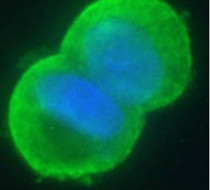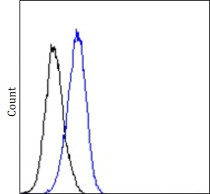ARG44258
anti-CD254 / RANKL antibody
anti-CD254 / RANKL antibody for Flow cytometry,ICC/IF and Human,Mouse
Overview
| Product Description | Goat Polyclonal antibody recognizes CD254 / RANKL |
|---|---|
| Tested Reactivity | Hu, Ms |
| Tested Application | FACS, ICC/IF |
| Specificity | This antibody is expected to recognise both reported isoforms |
| Host | Goat |
| Clonality | Polyclonal |
| Isotype | IgG |
| Target Name | CD254 / RANKL |
| Antigen Species | Human |
| Immunogen | Synthetic peptide around the internal region of Human CD254 / RANKL (DLAKRSKLEAQP) |
| Conjugation | Un-conjugated |
| Alternate Names | TRANCE; Osteoprotegerin ligand; CD254; sOdf; Receptor activator of nuclear factor kappa-B ligand; OPTB2; RANKL; OPGL; Tumor necrosis factor ligand superfamily member 11; hRANKL2; TNF-related activation-induced cytokine; Osteoclast differentiation factor; ODF; CD antigen CD254 |
Application Instructions
| Application Suggestion |
|
||||||
|---|---|---|---|---|---|---|---|
| Application Note | * The dilutions indicate recommended starting dilutions and the optimal dilutions or concentrations should be determined by the scientist. |
Properties
| Form | Liquid |
|---|---|
| Purification | Affinity purified |
| Buffer | Tris saline (pH 7.3), 0.02% Sodium azide and 0.5% BSA. |
| Preservative | 0.02% Sodium azide |
| Stabilizer | 0.5% BSA |
| Concentration | 0.5 mg/ml |
| Storage Instruction | For continuous use, store undiluted antibody at 2-8°C for up to a week. For long-term storage, aliquot and store at -20°C or below. Storage in frost free freezers is not recommended. Avoid repeated freeze/thaw cycles. Suggest spin the vial prior to opening. The antibody solution should be gently mixed before use. |
| Note | For laboratory research only, not for drug, diagnostic or other use. |
Bioinformation
| Database Links |
Swiss-port # O14788 Human Tumor necrosis factor ligand superfamily member 11 Swiss-port # O35235 Mouse Tumor necrosis factor ligand superfamily member 11 |
|---|---|
| Gene Symbol | TNFSF11 |
| Gene Full Name | tumor necrosis factor (ligand) superfamily, member 11 |
| Background | This gene encodes a member of the tumor necrosis factor (TNF) cytokine family which is a ligand for osteoprotegerin and functions as a key factor for osteoclast differentiation and activation. This protein was shown to be a dentritic cell survival factor and is involved in the regulation of T cell-dependent immune response. T cell activation was reported to induce expression of this gene and lead to an increase of osteoclastogenesis and bone loss. This protein was shown to activate antiapoptotic kinase AKT/PKB through a signaling complex involving SRC kinase and tumor necrosis factor receptor-associated factor (TRAF) 6, which indicated this protein may have a role in the regulation of cell apoptosis. Targeted disruption of the related gene in mice led to severe osteopetrosis and a lack of osteoclasts. The deficient mice exhibited defects in early differentiation of T and B lymphocytes, and failed to form lobulo-alveolar mammary structures during pregnancy. Two alternatively spliced transcript variants have been found. [provided by RefSeq, Jul 2008] |
| Function | Cytokine that binds to TNFRSF11B/OPG and to TNFRSF11A/RANK. Osteoclast differentiation and activation factor. Augments the ability of dendritic cells to stimulate naive T-cell proliferation. May be an important regulator of interactions between T-cells and dendritic cells and may play a role in the regulation of the T-cell-dependent immune response. May also play an important role in enhanced bone-resorption in humoral hypercalcemia of malignancy. [UniProt] |
| PTM | The soluble form of isoform 1 derives from the membrane form by proteolytic processing (By similarity). The cleavage may be catalyzed by ADAM17. |
Images (2) Click the Picture to Zoom In







